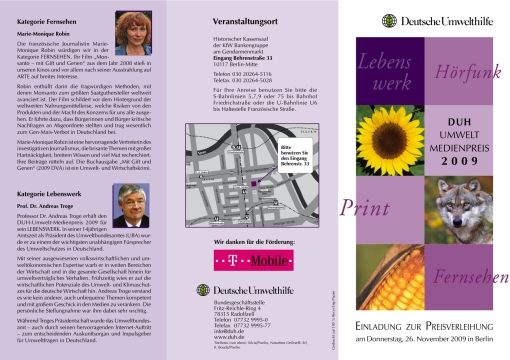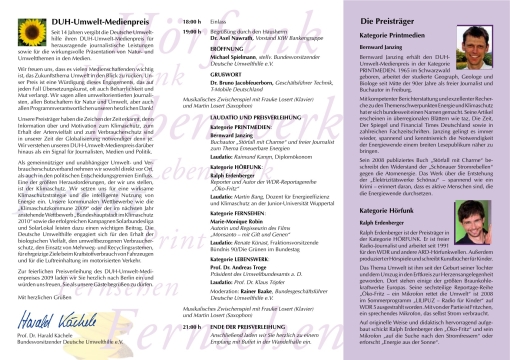Je suis dans le regret de vous informer que la projection de mon film « Torture made in USA » qui devait avoir lieu ce soir au siège du Parti communiste français, a été repoussée à une date ultérieure que je vous communiquerai bientôt. Je devais, en effet, partir demain en Inde, pour poursuivre le tournage de mon prochain film, mais mon départ a été avancé à aujourd’hui, en raison des vols des avions. Je suis rentrée, dimanche, d’un deuxième voyage en Amérique du Nord (Etats Unis, Canada). Je vous rappelle que mon film est disponible gratuitement sur le site de Mediapart jusqu’au 19 décembre.
Auteur : Marie-Monique
Monsanto a gagné un prix à Copenhague
Monsanto vient de remporter le Prix de la Sirène en Colère attribué aux entreprises qui exercent un lobbying incessant pour faire capoter les négociations sur le climat, en préconisant des solutions fallacieuses, comme le recours massif aux cultures transgéniques, censées réduire l’émission de CO2.
Vous pouvez visionner la vidéo présentant la petite sirène, gardienne de la mer et de l’univers, ainsi que la conférence de presse de désignation du lauréat sur le site de Greenpeace Canada.
Par ailleurs, pour les anglophones, je signale cette enquête de Associated Press qui confirme ce que j’écrivais dans mon livre: aux Etats Unis les actions en justice se multiplient contre Monsanto, soupçonné d’avoir violé la loi antitrust américaine en établissant un monopole sur les semences avec, notamment, des techniques de licences abusives passées avec les petites compagnies semencières contraintes de n’utiliser que les seuls gènes brevetés par Monsanto, ce qui est une entorse à la concurrence.
Monsanto seed business role revealed
AP IMPACT: Secret documents detail Monsanto’s seed business domination amid antitrust fears
By Christopher Leonard, AP Agribusiness Writer
On 1:45 pm EST, Sunday December 13, 2009
ST. LOUIS (AP) — Confidential contracts detailing Monsanto Co.’s business practices reveal how the world’s biggest seed developer is squeezing competitors, controlling smaller seed companies and protecting its dominance over the multibillion-dollar market for genetically altered crops, an Associated Press investigation has found.
With Monsanto’s patented genes being inserted into roughly 95 percent of all soybeans and 80 percent of all corn grown in the U.S., the company also is using its wide reach to control the ability of new biotech firms to get wide distribution for their products, according to a review of several Monsanto licensing agreements and dozens of interviews with seed industry participants, agriculture and legal experts.
Declining competition in the seed business could lead to price hikes that ripple out to every family’s dinner table. That’s because the corn flakes you had for breakfast, soda you drank at lunch and beef stew you ate for dinner likely were produced from crops grown with Monsanto’s patented genes.
Monsanto’s methods are spelled out in a series of confidential commercial licensing agreements obtained by the AP. The contracts, as long as 30 pages, include basic terms for the selling of engineered crops resistant to Monsanto’s Roundup herbicide, along with shorter supplementary agreements that address new Monsanto traits or other contract amendments.
The company has used the agreements to spread its technology — giving some 200 smaller companies the right to insert Monsanto’s genes in their separate strains of corn and soybean plants. But, the AP found, access to Monsanto’s genes comes at a cost, and with plenty of strings attached.
For example, one contract provision bans independent companies from breeding plants that contain both Monsanto’s genes and the genes of any of its competitors, unless Monsanto gives prior written permission — giving Monsanto the ability to effectively lock out competitors from inserting their patented traits into the vast share of U.S. crops that already contain Monsanto’s genes.
Monsanto’s business strategies and licensing agreements are being investigated by the U.S. Department of Justice and at least two state attorneys general, who are trying to determine if the practices violate U.S. antitrust laws. The practices also are at the heart of civil antitrust suits filed against Monsanto by its competitors, including a 2004 suit filed by Syngenta AG that was settled with an agreement and ongoing litigation filed this summer by DuPont in response to a Monsanto lawsuit.
The suburban St. Louis-based agricultural giant said it’s done nothing wrong.
« We do not believe there is any merit to allegations about our licensing agreement or the terms within, » said Monsanto spokesman Lee Quarles. He said he couldn’t comment on many specific provisions of the agreements because they are confidential and the subject of ongoing litigation.
« Our approach to licensing (with) many companies is pro-competitive and has enabled literally hundreds of seed companies, including all of our major direct competitors, to offer thousands of new seed products to farmers, » he said.
The benefit of Monsanto’s technology for farmers has been undeniable, but some of its major competitors and smaller seed firms claim the company is using strong-arm tactics to further its control.
« We now believe that Monsanto has control over as much as 90 percent of (seed genetics). This level of control is almost unbelievable, » said Neil Harl, agricultural economist at Iowa State University who has studied the seed industry for decades. « The upshot of that is that it’s tightening Monsanto’s control, and makes it possible for them to increase their prices long term. And we’ve seen this happening the last five years, and the end is not in sight. »
At issue is how much power one company can have over seeds, the foundation of the world’s food supply. Without stiff competition, Monsanto could raise its seed prices at will, which in turn could raise the cost of everything from animal feed to wheat bread and cookies.
The price of seeds is already rising. Monsanto increased some corn seed prices last year by 25 percent, with an additional 7 percent hike planned for corn seeds in 2010. Monsanto brand soybean seeds climbed 28 percent last year and will be flat or up 6 percent in 2010, said company spokeswoman Kelli Powers.
Monsanto’s broad use of licensing agreements has made its biotech traits among the most widely and rapidly adopted technologies in farming history. These days, when farmers buy bags of seed with obscure brand names like AgVenture or M-Pride Genetics, they are paying for Monsanto’s licensed products.
One of the numerous provisions in the licensing agreements is a ban on mixing genes — or « stacking » in industry lingo — that enhance Monsanto’s power.
One contract provision likely helped Monsanto buy 24 independent seed companies throughout the Farm Belt over the last few years: that corn seed agreement says that if a smaller company changes ownership, its inventory with Monsanto’s traits « shall be destroyed immediately. »
Another provision from contracts earlier this decade– regarding rebates — also help explain Monsanto’s rapid growth as it rolled out new products.
One contract gave an independent seed company deep discounts if the company ensured that Monsanto’s products would make up 70 percent of its total corn seed inventory. In its 2004 lawsuit, Syngenta called the discounts part of Monsanto’s « scorched earth campaign » to keep Syngenta’s new traits out of the market.
Quarles said the discounts were used to entice seed companies to carry Monsanto products when the technology was new and farmers hadn’t yet used it. Now that the products are widespread, Monsanto has discontinued the discounts, he said.
The Monsanto contracts reviewed by the AP prohibit seed companies from discussing terms, and Monsanto has the right to cancel deals and wipe out the inventory of a business if the confidentiality clauses are violated.
Thomas Terral, chief executive officer of Terral Seed in Louisiana, said he recently rejected a Monsanto contract because it put too many restrictions on his business. But Terral refused to provide the unsigned contract to AP or even discuss its contents because he was afraid Monsanto would retaliate and cancel the rest of his agreements.
« I would be so tied up in what I was able to do that basically I would have no value to anybody else, » he said. « The only person I would have value to is Monsanto, and I would continue to pay them millions in fees. »
Independent seed company owners could drop their contracts with Monsanto and return to selling conventional seed, but they say it could be financially ruinous. Monsanto’s Roundup Ready gene has become the industry standard over the last decade, and small companies fear losing customers if they drop it. It also can take years of breeding and investment to mix Monsanto’s genes into a seed company’s product line, so dropping the genes can be costly.
Monsanto acknowledged that U.S. Department of Justice lawyers are seeking documents and interviewing company employees about its marketing practices. The DOJ wouldn’t comment.
A spokesman for Iowa Attorney General Tom Miller said the office is examining possible antitrust violations. Additionally, two sources familiar with an investigation in Texas said state Attorney General Greg Abbott’s office is considering the same issues. States have the authority to enforce federal antitrust law, and attorneys general are often involved in such cases.
Monsanto chairman and chief executive officer Hugh Grant told investment analysts during a conference call this fall that the price increases are justified by the productivity boost farmers get from the company’s seeds. Farmers and seed company owners agree that Monsanto’s technology has boosted yields and profits, saving farmers time they once spent weeding and money they once spent on pesticides.
But recent price hikes have still been tough to swallow on the farm.
« It’s just like I got hit with bad weather and got a poor yield. It just means I’ve got less in the bottom line, » said Markus Reinke, a corn and soybean farmer near Concordia, Mo. who took over his family’s farm in 1965. « They can charge because they can do it, and get away with it. And us farmers just complain, and shake our heads and go along with it. »
Any Justice Department case against Monsanto could break new ground in balancing a company’s right to control its patented products while protecting competitors’ right to free and open competition, said Kevin Arquit, former director of the Federal Trade Commission competition bureau and now a antitrust attorney with Simpson Thacher & Bartlett LLP in New York.
« These are very interesting issues, and not just for the companies, but for the Justice Department, » Arquit said. « They’re in an area where there is uncertainty in the law and there are consumer welfare implications and government policy implications for whatever the result is. »
Other seed companies have followed Monsanto’s lead by including restrictive clauses in their licensing agreements, but their products only penetrate smaller segments of the U.S. seed market. Monsanto’s Roundup Ready gene, on the other hand, is in such a wide array of crops that its licensing agreements can have a massive effect on the rules of the marketplace.
Monsanto was only a niche player in the seed business just 12 years ago. It rose to the top thanks to innovation by its scientists and aggressive use of patent law by its attorneys.
First came the science, when Monsanto in 1996 introduced the world’s first commercial strain of genetically engineered soybeans. The Roundup Ready plants were resistant to the herbicide, allowing farmers to spray Roundup whenever they wanted rather than wait until the soybeans had grown enough to withstand the chemical.
The company soon released other genetically altered crops, such as corn plants that produced a natural pesticide to ward off bugs. While Monsanto had blockbuster products, it didn’t yet have a big foothold in a seed industry made up of hundreds of companies that supplied farmers.
That’s where the legal innovations came in, as Monsanto became among the first to widely patent its genes and gain the right to strictly control how they were used. That control let it spread its technology through licensing agreements, while shaping the marketplace around them.
Back in the 1970s, public universities developed new traits for corn and soybean seeds that made them grow hardy and resist pests. Small seed companies got the traits cheaply and could blend them to breed superior crops without restriction. But the agreements give Monsanto control over mixing multiple biotech traits into crops.
The restrictions even apply to taxpayer-funded researchers.
Roger Boerma, a research professor at the University of Georgia, is developing specialized strains of soybeans that grow well in southeastern states, but his current research is tangled up in such restrictions from Monsanto and its competitors.
« It’s made one level of our life incredibly challenging and difficult, » Boerma said.
The rules also can restrict research. Boerma halted research on a line of new soybean plants that contain a trait from a Monsanto competitor when he learned that the trait was ineffective unless it could be mixed with Monsanto’s Roundup Ready gene.
Boerma said he hasn’t considered asking Monsanto’s permission to mix its traits with the competitor’s trait.
« I think the co-mingling of their trait technology with another company’s trait technology would likely be a serious problem for them, » he said.
Quarles pointed out that Monsanto has signed agreements with several companies allowing them to stack their traits with Monsanto’s. After Syngenta settled its lawsuit, for example, the companies struck a broad cross-licensing accord.
At the same time, Monsanto’s patent rights give it the authority to say how independent companies use its traits, Quarles said.
« Please also keep in mind that, as the (intellectual property developer), it is our right to determine who will obtain rights to our technology and for what purpose, » he said.
Monsanto’s provision requiring companies to destroy seeds containing Monsanto’s traits if a competitor buys them prohibited DuPont or other big firms from bidding against Monsanto when it snapped up two dozen smaller seed companies over the last five years, said David Boies, a lawyer representing DuPont who previously was a prosecutor on the federal antitrust case against Microsoft Corp.
Competitive bids from companies like DuPont could have made it far more expensive for Monsanto to bring the smaller companies into its fold. But that contract provision prevented bidding wars, according to DuPont.
« If the independent seed company is losing their license and has to destroy their seeds, they’re not going to have anything, in effect, to sell, » Boies said. « It requires them to destroy things — destroy things they paid for — if they go competitive. That’s exactly the kind of restriction on competitive choice that the antitrust laws outlaw. »
Quarles said some of the Monsanto contracts let companies sell their inventory for a period of time, rather than be required to destroy it. Seed companies also don’t have to pay royalty fees on the bags of seed they destroyed.
« Simply put, it was designed to facilitate early adoption of the technology, » he said.
Some independent seed company owners say they feel increasingly pinched as Monsanto cements its leadership in the industry.
« They have the capital, they have the resources, they own lots of companies, and buying more. We’re small town, they’re Wall Street, » said Bill Cook, co-owner of M-Pride Genetics seed company in Garden City, Mo., who also declined to discuss or provide the agreements. « It’s very difficult to compete in this environment against companies like Monsanto. »
Copyright © 2009 The Associated Press. All rights reserved
projection de « Torture made in USA » au siège du PCF
Mon film « Torture made in USA » sera présenté le mercredi 16 décembre, à 18 heures 30, au siège du Parti Communiste Français, Place du Colonel Fabien. Je répondrai aux questions du public. Venez nombreux!
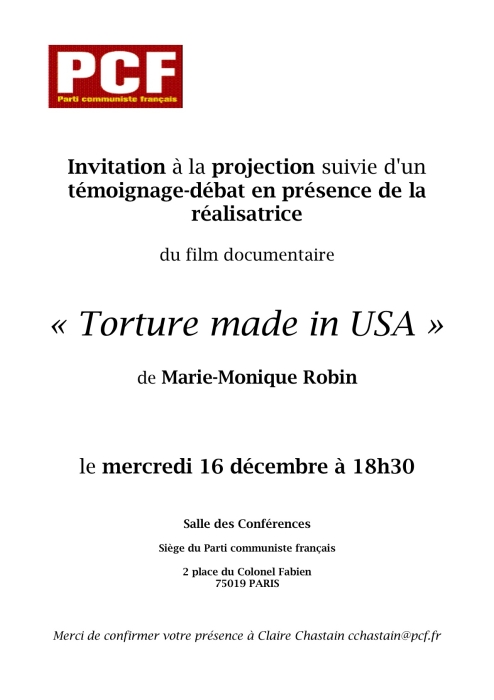
les OGM de Monsanto entraînent une augmentation de la consommation d’herbicides
J’étais récemment dans l’Etat du Minnesota (USA), et très précisément dans la Red River Valley, une région d’agriculture intensive où l’on cultive à perte de vue le soja Roundup Ready de Monsanto.
Accompagnée d’un scientifique et d’un technicien agricole de l’Université de Minneapolis, j’ai rencontré des farmers qui m’ont confirmé ce que je décrivais déjà dans mon livre, et sur mon Blog: leurs champs sont envahis par des mauvaises herbes résistantes au roundup, entraînant une augmentation exponentielle de leur consommation d’herbicides!
Mieux: ils m’ont assuré qu’ils voulaient renoncer aux OGM de Monsanto pour retourner à des semences de soja conventionnel, qu’ils ont d’ailleurs bien du mal à trouver, en raison du (quasi) monopole de Monsanto sur les semences (cf. mon livre).
« Les paysans de la région se détournent de plus en plus des OGM » m’a , pour sa part , raconté Nick Kgar, un journaliste d’une télévision locale de Fargo (le « Fargo » des Frères Cohen!) , qui a tenu à m’interviewer, dès qu’il a su que j’étais de passage dans la région (voir photos).
Aujourd’hui, tout ce que je rapportais déjà dans mon livre a été confirmé par le dernier rapport, publié par Charles Benbrook , qui fut directeur de la division agricole de la prestigieuse Académie nationale des sciences, avant de créer un centre de promotion de l’agriculture biologique.
Intitulé « Impacts of Genetically Engineered Crops on Pesticide Use: the Firts Thirteen Years », ce rapport confirme ce que Charles Benbrook avait déjà constaté dans ses études précédents (voir mon livre et Blog): contrairement aux promesses de Monsanto, les OGM roundup ready n’ont pas entraîné une baisse de la consommation d’herbicides, mais une augmentation de + 382 millions de livres depuis leur introduction en 1996.
Les anglophones peuvent lire ce rapport ici
Les non anglophones peuvent lire cet article du Monde, publié le 29 novembre dernier que je copie, en y ajoutant un commentaire:
Les organismes génétiquement modifiés (OGM) permettent-ils de réduire la consommation de pesticides ? L’argument, contesté par les écologistes, est mis en avant par les entreprises de semences transgéniques. Une étude, publiée en novembre par The Organic Center, un centre de recherche américain opposé aux biotechnologies, ravive ce débat en affirmant que la généralisation du soja, du maïs, et du coton OGM aux Etats-Unis depuis 1996 a abouti à une surconsommation de pesticides de 144 000 tonnes (soit deux fois la quantité utilisée par an en France).
Le directeur scientifique du centre, Charles Benbrook, ancien directeur du bureau de l’agriculture de l’Académie des sciences américaine, devenu consultant, a utilisé les données collectées chaque année par le ministère américain de l’agriculture (USDA), qui évalue par sondage les surfaces traitées et les quantités appliquées par hectare. Ces données ne distinguant pas les plantes transgéniques des conventionnelles, M. Benbrook a donc estimé « l’impact » des biotechnologies en mettant en équation les chiffres de l’USDA avec des estimations – effectuées à partir de données publiques – des traitements appliqués en moyenne en fonction des modes de culture.
Selon ces résultats, l’utilisation de maïs et de coton génétiquement modifiés pour sécréter une toxine mortelle pour les insectes ravageurs (plantes Bt) aurait permis « d’économiser » 29 000 tonnes d’insecticides depuis 1996. En revanche, la généralisation du soja Round Up Ready (RR), conçu par Monsanto pour résister au passage de son herbicide vedette, aurait abouti à une surconsommation de 173 000 tonnes d’herbicides.
Le soja RR a conquis les agriculteurs américains : il représente 90 % des surfaces cultivées de soja. « C’est ce succès qui a entraîné l’accroissement des quantités de pesticides utilisées, affirme Charles Benbrook. L’utilisation d’un seul herbicide a favorisé l’apparition de mauvaises herbes résistantes. Plus on avance dans le temps, moins le système marche. Une seule application suffisait au départ pour contrôler les mauvaises herbes. Deux à trois sont parfois nécessaires aujourd’hui. »
« DONNÉES INCOMPLÈTES »
Le rapport de M. Benbrook est contesté par le cabinet de conseil britannique PG Economics, spécialisé dans l’analyse de l’impact des biotechnologies – et en général favorable à ces dernières. « M. Benbrook utilise des données incomplètes de façon erronée », résume Graham Brookes, de PG Economics. Premier écueil : les données de l’USDA s’arrêtent en 2007 pour le coton, en 2006 pour le soja et en 2005 pour le maïs. Elles ont été complétées par extrapolation par M. Benbrook. Deuxième critique : ce dernier sous-évaluerait les traitements réalisés par les cultivateurs de soja traditionnel, peu nombreux aux Etats-Unis, donc jugés non représentatifs.
PG Economics utilise les données commercialisées par l’organisme privé DMR Kynetec, qui procède par sondage et, contrairement à l’USDA, distingue les modes de culture. Selon ces chiffres, M. Benbrook surestime l’utilisation des herbicides de 28 000 tonnes sur la période étudiée. Les mêmes données confirment toutefois une tendance à l’augmentation de l’usage des herbicides sur le soja OGM américain depuis le début des années 2000, de 10 % à 15 % par rapport à la période antérieure à 1996. Il augmente également sur le coton (de 18 % à 22 %), mais baisse sur le maïs (8 % à 12 %).
A ce débat sur les tonnages utilisés s’ajoute une controverse sur le glyphosate, la molécule active du Round Up, présentée comme moins dangereuse que celles qu’elle a remplacées. « C’est l’une des moins nocives utilisées actuellement, mais elle n’est pas sans risque », répond M. Benbrook.
Gaëlle Dupont
Mon commentaire:
Ce que ne dit pas Gaëlle Dupont c’est que Charles Benbrook ne pouvait pas utiliser les données de l’USDA de 2008, tout simplement parce que le secrétariat à l’agriculture a décidé d’arrêter de les rendre publiques!
Cette décision a provoqué de nombreuses réactions aux Etats Unis provenant d’ONG, comme Greenpeace ou WWF, mais aussi de l’Association des producteurs de soja (ASA) ou de Syngenta, le concurrent suisse de Monsanto, qui ont tous écrit à l’USDA lui demandant de revenir sur cette bien étrange décision. Seul Monsanto n’a pas écrit, ainsi que l’ont révélé plusieurs journaux ou sites comme celui-ci.
Je traduis ce que dit Charles Benbrook dans cet article:
« Les données de 2007 auraient montré une augmentation énorme de la quantité d’herbicides épandus sur les cultures roundup ready, en particulier de soja. Les médias agricoles ne cessent de rapporter des histoires , au cours des dernières années, au sujet d’agriculteurs confrontés à des mauvaises herbes résistantes au glyphosate et à d’autres herbicides. Je trouve curieux que le Département de l’agriculture ait décidé d’arrêter de collecter les données, précisément au moment où il y a un intérêt majeur et un besoin d’informations solides sur l’usage des pesticides dans les cultures de soja. Je ne serais pas surpris qu’il y ait eu un lobbying discret de Monsanto pour faire enterrer ce programme ».
Photo: avec Nick Kgar, le journaliste de Fargo.
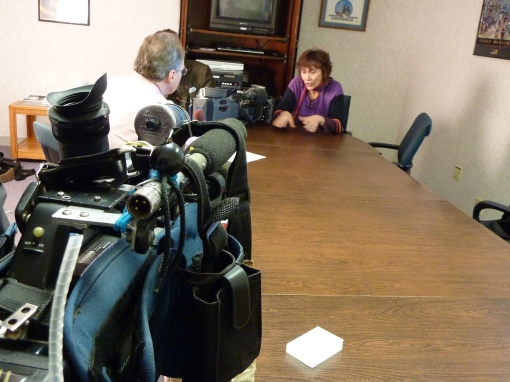

Le prix à Berlin
Je suis donc allée à Berlin chercher le prix des médias octroyé par l’organisation Deutsche Umwelthilfe, dans la catégorie « Télévision ».
Une soirée pleine d’émotions qui m’a propulsée trente ans en arrière, lorsque j’étudiais notamment l’allemand et les sciences politiques en Allemagne. C’était entre 1978 et 1982, à l’époque où était créé le parti vert allemand, une expérience fondamentale, puisque c’est là que j’ai compris que l’écologie n’était pas un gadget de bobos ni de nostalgiques inadaptés à leur temps, mais au contraire une exigence politique devant s’accompagner de la remise en question d’un modèle économique basé sur la croissance infinie, et l’exploitation criminelle des hommes et des ressources naturelles.
Lors du petit « speech » (bientôt en ligne) que j’ai tenu devant une assemblée d’unecentaine d’invités, j’ai rappelé que j’avais alors écrit mon « Magisterarbeit » (sorte de « maîtrise ») sur les « mouvements alternatifs » expérimentés alors à Berlin Ouest, à quelques encâblures du « mur de la honte »…
C’est d’ailleurs Renate Kunast, ancienne ministre de l’environnement du gouvernement SPD-Verts de Gerhard Schröder, qui a fait mon « Laudatio » (hommage), que je mettrai aussi bientôt en ligne.
Un moment particulièrement fort de la soirée fut une vidéo projetée, à ma grande surprise, où le président de Deutsche Umwelthilfe a demandé à Vandana Shiva de dire quelques mots sur mon prix, lors de son passage à Berlin quelques jours plus tôt (voir vidéo)…
Enfin, je suis heureuse de vous informer que la chaîne américaine Sundance Channel, créée par Robert Redford, diffuse mon documentaire depuis une semaine:
www.sundancechannel.com/films/500335405
Photos:
– Renate Kunast pendant le « laudatio »
– La remise du prix
– Photo souvenir avec les organisateurs du prix, et les trois autres lauréats: Bernward Janzing (presse écrite), Ralph Erdenberger (radio) et Prof. Andreas Troge (carrière), ancien président du Umweltbundesamt (agence allemande de l’environnement). Que d’hommes!!
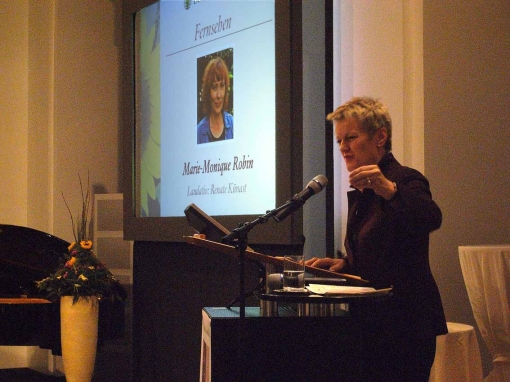
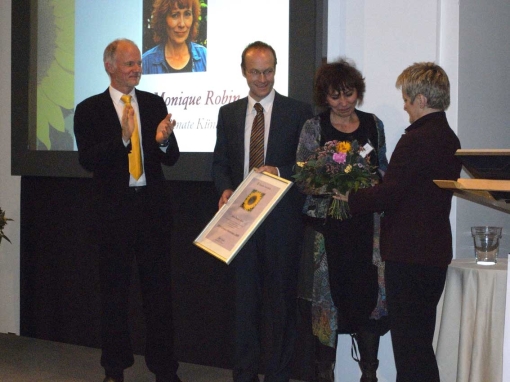
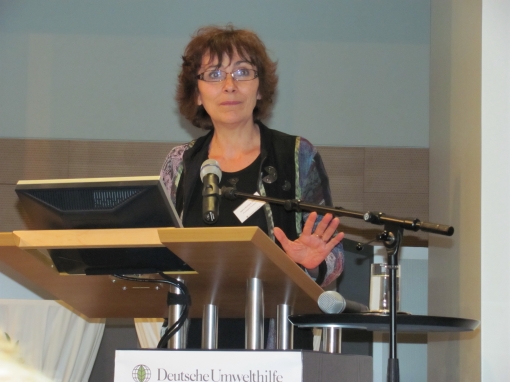
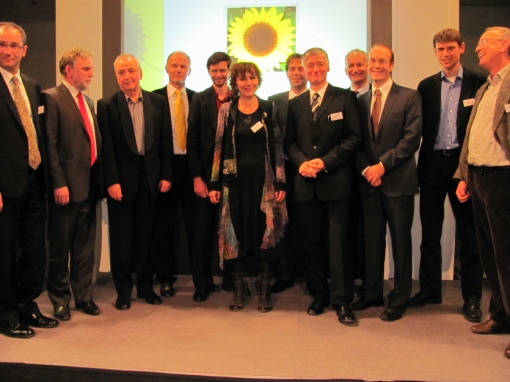
Quelques nouvelles: deux nouveaux prix pour « Le monde selon Monsanto »
Après un long tournage aux Etats Unis (trois semaines) et un plus court au Chili (cinq jours), me voici de retour à Paris pour quelques jours!
Je viens de recevoir par la poste le prix que j’ai gagné à l’Ekofilm Festival de Cesky Kumlov, en république tchèque, le 14 octobre dernier, et que je n’ai pas pu aller chercher en raison de ma nouvelle enquête.
Par ailleurs, le 26 novembre, je me rendrai à Berlin où me sera remis le « Umwelt-Medienpreis » (voir invitation) par Renate Künast, l’ancienne ministre de l’environnement du gouvernement Schröder.
Dans la présentation du film, on peut notamment lire:
« Le film a permis aux citoyens et citoyennes d’adresser des questions critiques à leurs députés et a nettement contribué à l’interdiction du maïs transgénique en Allemagne ».
